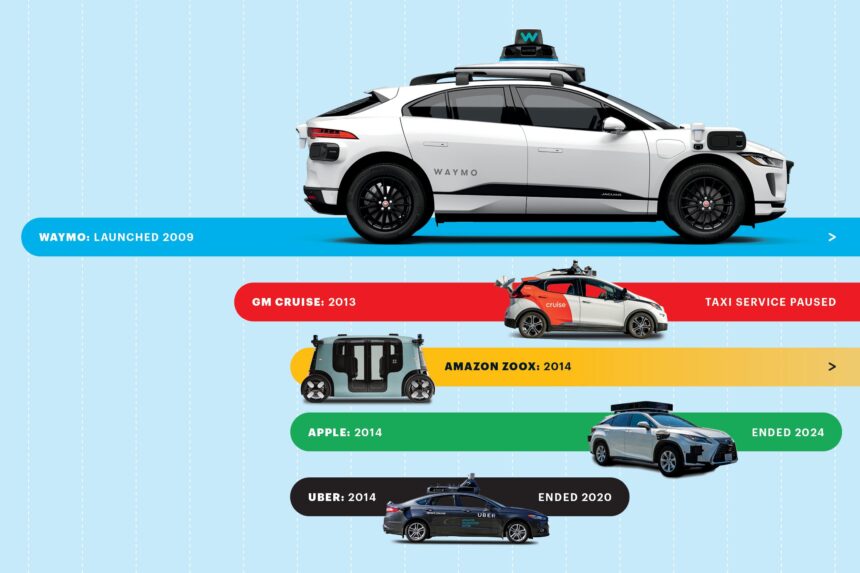In a significant expansion of its autonomous ride-hailing services, Waymo has announced the enlargement of its operational areas around two of California’s largest metropolitan regions, San Francisco and Los Angeles. This development marks a pivotal moment for the self-driving technology company, which aims to enhance accessibility and convenience for residents while further cementing its position in the competitive landscape of autonomous transportation. With this latest move, Waymo seeks to increase its fleet’s reach, offering more residents the opportunity to experience the future of mobility. The decision reflects not only Waymo’s confidence in its self-driving technology but also the growing demand for innovative transportation solutions in urban environments. As the company rolls out this expansion, questions arise regarding regulatory implications, safety measures, and the potential impact on local transportation dynamics.
Waymo Enhances Autonomous Ride-Hailing Services in Key California Markets
Waymo has marked a significant milestone in the evolution of autonomous ride-hailing by expanding its service area in California. The company now offers its fully autonomous rides in a wider range around major metropolitan hubs like San Francisco and Los Angeles. This expansion aims to meet the growing demand for safe and convenient transportation options, particularly as cities embrace the benefits of self-driving technology. Passengers can now enjoy driverless rides that seamlessly integrate into their daily commutes, school runs, and leisure activities.
The enhanced services come equipped with cutting-edge technology that ensures a safer and more efficient ride experience. Key features of Waymo’s autonomous vehicles include:
- 24/7 Availability: Rides can be requested at any time, improving accessibility.
- Safety Measures: Advanced sensors and AI-driven systems help navigate complex urban environments.
- Eco-Friendly Fleet: The vehicles are electric, contributing to reduced emissions in Californian cities.
Additionally, Waymo is actively collaborating with local government regulations to ensure compliance and foster public trust. With these enhancements, the company is not only setting superior standards for autonomous transportation but also paving the way for a future where personal vehicles may become obsolete in urban centers.
Insights on the Expansion Plans and Technological Innovations Driving Waymo’s Growth
Waymo’s recent decision to expand its service area around San Francisco and Los Angeles reflects a strategic approach to not only increase its operational footprint but also to enhance its user base. The expansion is underpinned by key innovations in autonomous driving technology and a commitment to improving user experience. By integrating advanced machine learning algorithms and high-definition mapping, Waymo can now provide more reliable and efficient transportation solutions.
Key elements of Waymo’s expansion strategy include:
- Enhanced Safety Features: Continuous updates to software algorithms that prioritize passenger safety.
- Real-Time Traffic Adaptability: Improved systems that adapt to dynamic road conditions, ensuring smoother rides.
- User-Centric Interface: Development of a more intuitive app experience for riders to easily book rides.
As it grows, Waymo is not merely expanding its geographical presence but is also making significant advancements in the technology that underlies its service. The company is investing heavily in research and development, focusing on developments that will promote scalability and integration with other transportation modes. Current investments are directed towards:
| Innovation | Impact |
|---|---|
| AI-Powered Navigation | Enhances route optimization and reduces travel times. |
| Vehicle-to-Everything (V2X) Communication | Improves safety through interaction with traffic signals and other vehicles. |
| Electric Vehicle Integration | Supports sustainability goals and lowers operating costs. |
Recommendations for Future Urban Mobility and Infrastructure Adaptation in Expanding Areas
As urban centers like San Francisco and Los Angeles continue to evolve, adapting infrastructure to accommodate expanding autonomous vehicle services will be crucial. To successfully integrate this technology, municipalities should consider implementing infrastructure that promotes seamless connectivity. Recommendations include:
- Dedicated lanes for autonomous vehicles: Establishing specific lanes that are reserved for self-driving cars can mitigate congestion and enhance safety.
- Smart traffic signals: Upgrading traffic control systems to communicate with autonomous vehicles may improve flow and reduce wait times at intersections.
- Multimodal transport hubs: Designing stations that enable easy transfers between autonomous vehicles, public transit, and bicycles can create a more versatile transportation ecosystem.
Moreover, investment in public education and outreach is essential to foster acceptance of autonomous technologies among residents. City planners should engage with communities to understand their needs and address concerns regarding safety and job displacement. Prioritizing the following strategies could prove effective:
- Community workshops: Hosting informative sessions can demystify autonomous technology and build public trust.
- Data transparency initiatives: Providing clear data on operational safety and performance metrics can alleviate fears and bolster community confidence.
- Partnerships with local organizations: Collaborating with community groups can ensure that the implementation of autonomous services aligns with the social fabric of neighborhoods.
In Summary
In conclusion, Waymo’s expansion of its self-driving car service around San Francisco and Los Angeles marks a significant step in the evolution of autonomous transportation. With the addition of new neighborhoods and increased accessibility, Waymo continues to lead the way in reshaping urban mobility. As the company navigates regulatory landscapes and consumer acceptance, it remains to be seen how these developments will influence the future of ride-hailing and public transport. As cities adapt to these innovations, the implications for traffic patterns, urban planning, and environmental sustainability will be felt for years to come. As Waymo pushes forward, the possibility of a driverless future inches closer to reality, potentially transforming the everyday commute for millions.









